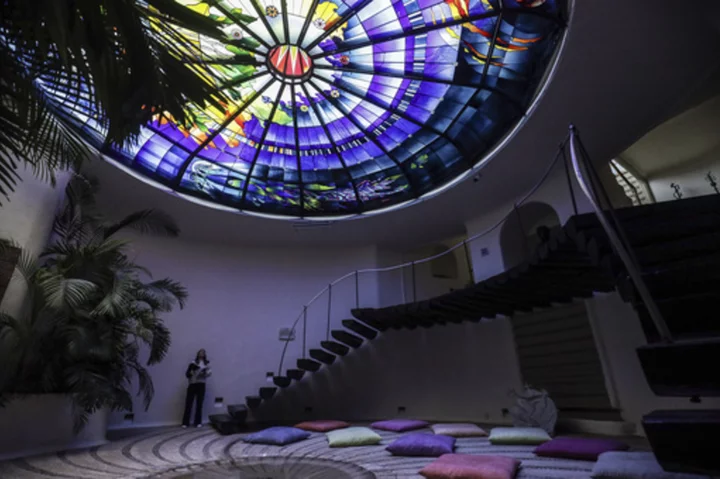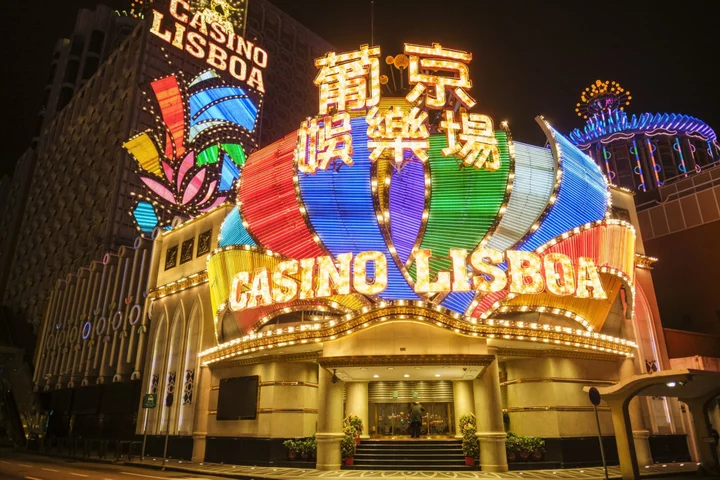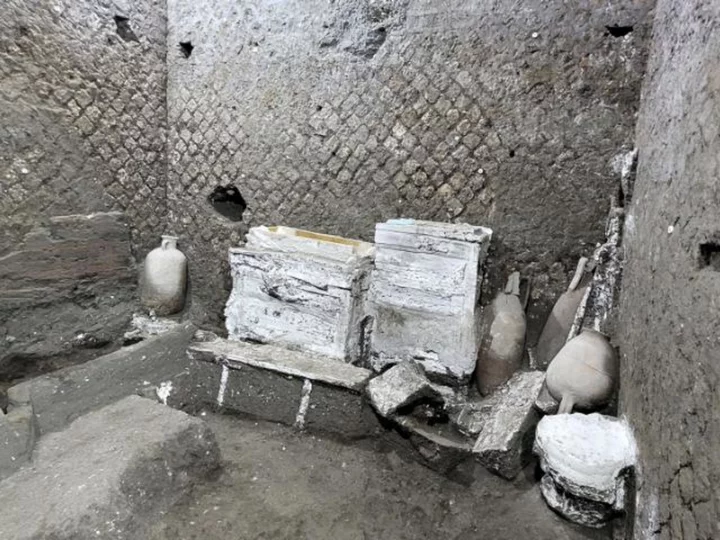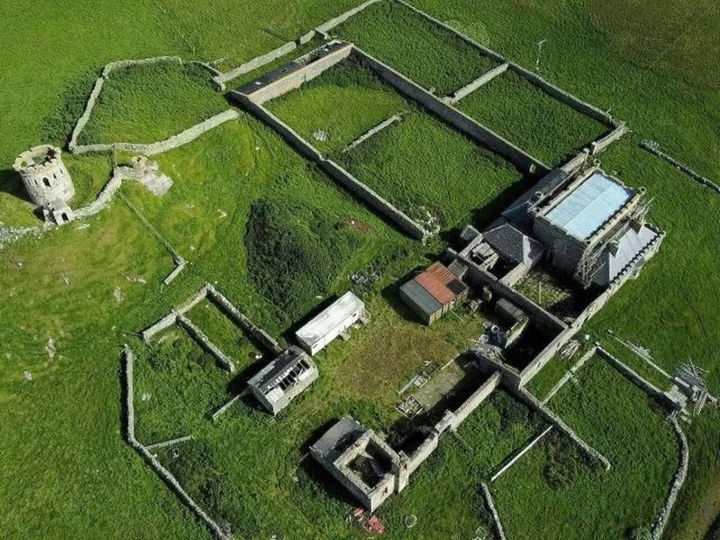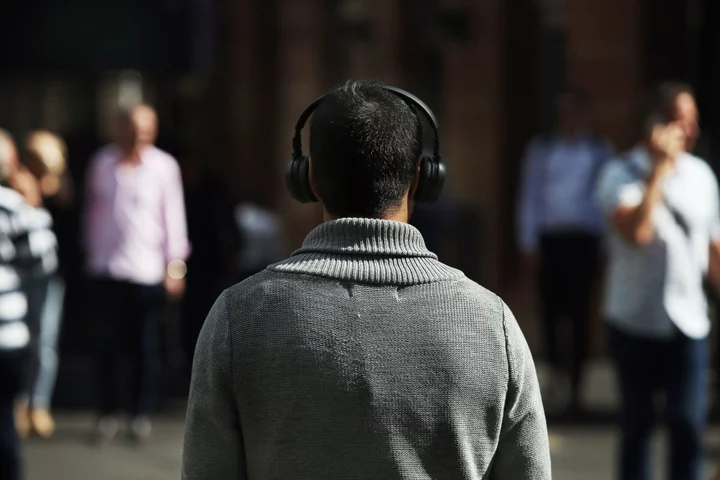VALLE DE BRAVO, Mexico (AP) — It’s as if Narcissus Quagliata is painting with light.
He sprinkles the crushed, colorful glass onto a template of his own design before baking the powder-coated pane at nearly 1,500 degrees Fahrenheit for almost an entire day. Once cooled, a translucent, stained-glass image emerges.
“The light, with the glass, moves you to the core,” said Quagliata, an 81-year-old master of his craft, on a recent day at his studio in Valle de Bravo, near Mexico City. “It’s profound.”
Over the last five decades, Quagliata has created these stained-glass artworks for sacred spaces, private homes and public exhibitions, using a fusible glass technique he considers his most precious legacy.
The scope of Quagliata’s invention can be seen in “Holy Frit,” a documentary recently released in U.S. In the film, the Italian artist serves as a mentor-like figure for Tim Carey, a young American colleague who found himself facing the greatest challenge of his artistic career.
In 2015, Carey was appointed lead artist for a colossal project, a stained-glass window more than 90 feet long and nearly 40 feet high for a new church building in Leawood, Kansas. By 2017, “The Resurrection Window” would become the focal point in Resurrection’s sanctuary – the home base for the largest United Methodist congregation in the U.S.
“My hope is the window acts like a sacrament, as a visible means of grace through which God communicates and says: I’m here,” Hamilton said in “Holy Frit.”
But first Carey needed to figure out how he and his team would pull off the 161-panel window, with each panel measuring 4 feet by 5 feet, in a few years’ time.
Carey created 76 sketches before getting the pastor’s approval. What he kept silent, though, was a technical dilemma: he had no idea how to mix more than one color in a panel, as his sketch proposed. So, he called the maestro.
“Narcissus is like the Steven Spielberg of stained glass,” Carey said in “Holy Frit.”
Before Quagliata perfected his fusing technique, stained-glass panels primarily were separate pieces held together by lead strips. A few artists tried to merge colors with extreme heat, but most failed.
It’s simple chemistry, Quagliata said. Each color possesses minerals which determine its cooling temperature, so even if blue and red could fuse inside an oven, the glass would break up in the end.
“Fusible glass means you can create an image with glass and no lead,” Quagliata said. “You can use 80 colors and it won’t break”.
Though he had spent the last four decades mastering his craft, “The Resurrection Window” made Quagliata nervous. He had never before depicted 90 human figures in fusible glass.
The power of light and glass struck him in the 1960s, soon after he left Rome to become an artist in the United States. Walking through the Metropolitan Museum of Art, in New York, 19-year-old Quagliata saw works by painter Marc Chagall and was hit with a powerful dose of inspiration.
Before long he moved to California, where the surge of the Arts and Crafts Movement convinced him to let go of his dreams of becoming a traditional painter like Picasso and embrace painting through stained-glass instead.
“I kept thinking: What I would do with red glass, with blue glass?” Quagliata said.
In “The Resurrection Window,” Christ’s skin is yellow. Light-red patches frame the nose. Bright layers of purple, pink and green coat his eyes. The design was Carey’s, but the subtle fusion of colors was Quagliata’s work.
Members of the congregation wept on the day the panel was hung in the church.
“Fusing glass is spontaneous,” Quagliata said. “It awakens a genuine feeling that is rare in religious painting.”
In the glassworks and watercolors that he keeps in the studio where he has lived since the early 2000s, no religious motifs can be seen. A masculine figure in red portrays a prisoner, while a blue profile depicts what could have been a Greek sculpture sunk by the Romans in the sea.
“My career is defined by three things: the first one is the light; another one is the love for the human figure – very beautiful or very distorted – and finally the approach towards something social.”
“The Resurrection Window” took a while to complete, but The Dome of Light, in Taiwan, which holds a special place in his heart, took even longer. The stained-glass piece is made of 1,152 panels, distributed along 30 meters (98 feet) in diameter, and it took Quagliata and his 20 assistants five years of hard work.
“When I came back, I was depressed for months,” Quagliata said. “It was like winning the Olympics and coming back to perform in a local race.”
What took him out of his sadness was answering a question: When was I the happiest as an artist? And it became clear. He was young and could barely pay his studio’s rent, but he was energetic and the faith he put in his glassworks was enough to devote his life to them.
“I told myself, instead of thinking about the past, think about what you want in the future and do it as adventurously and passionately as you did when you were young,” Quagliata said.
And so, he learned how to teach remotely. He faced his fears of technology and – coached by his daughter, an experimental video artist — he started crafting a digital masterclass.
He also remodeled his studio and says he hopes to take in students from abroad.
“I’m more than 80 now, so I don’t like to travel anymore,” Quagliata said. “But if I’m healthy, instead of going out to the world to teach, I’d love the world to come to me.”
___
Associated Press religion coverage receives support through the AP’s collaboration with The Conversation US, with funding from Lilly Endowment Inc. The AP is solely responsible for this content.

